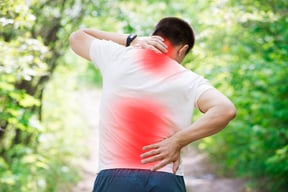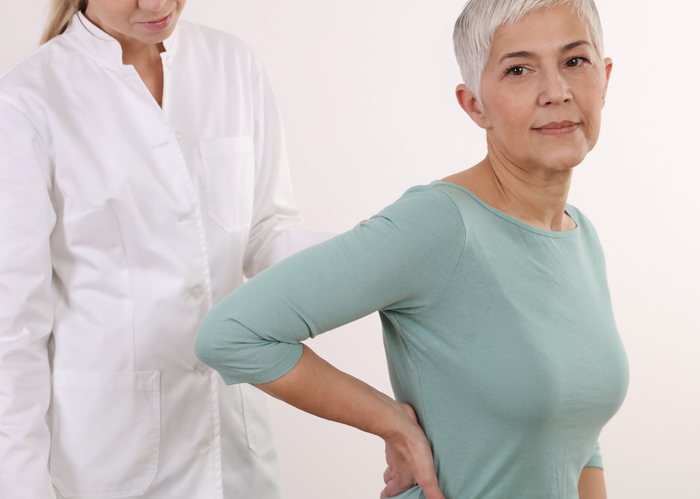Lower back pain can be traced back to a number of different causes. Learn more about the cause and steps you can take for pain relief.
There are a number of injuries and health conditions that can cause an individual lower back pain. Some of the more notable amongst them include:

- Disk injury
- When disks are injured, they oftentimes irritate nearby nerves and cause pain, numbness, or weakness
- Most disk injuries occur in your lower back (known as the lumbar spine)
- May be accompanied by pain in the buttocks, thighs, or calves
- Strains
- Caused by injuries to muscles or tendons
- Not to be confused with back sprains, which occur when a ligament is torn to stretched
- Twisting or pulling muscles and tendons can lead to a strain
- Improper lifting or over stressing the back muscles also regularly result in strains
- Sciatica
- Pain that radiates along the sciatic nerve .
- This nerve branches out from the lower back through the hips and buttocks before continuing down each leg
- Often affects only one side of the body
- Spine curvature
- Three key spine curvature disorders: lordosis, kyphosis, and scoliosis
- Lordosis is also known as swayback; the spine curves inward at the lower back
- Kyphosis causes an abnormally-rounded upper back
- Scoliosis causes a sideways curve (typically S- or C-shaped) in the spine
- Spinal stenosis
- The spaces within the spine are narrowed
- This leads to pressure on the nerves throughout the spine
- Sufferers may experience pain, tingling, muscle weakness, and numbness
- Typically caused by wear and tear to the spine related to osteoarthritis
Other notable conditions that may lead to back pain:
- Arthritis
- Lumbar osteoarthritis is a very painful condition which impacts the lower back
- Fibromyalgia
- Chronic pain and tenderness in the joints, muscles, and tendons
- Spondylitis
- Inflammation of the joints between the spinal bones
- Spondylosis
- Also known as spinal osteoarthritis
- Degenerative disorder that may cause loss of normal spine structure and function
- Infections of the bladder
Lower Back Pain Treatment at Home
It's critical that lower back pain sufferers begin self-care practices within the first 72 hours following the onset of pain. Self-care encompasses a wide variety of practices, but in this case can include:
- Rest
- RICE protocol
- Rest, ice, compression, and elevation
- Recommended within the first 48 hours
- Alternating ice packs with heating pads to promote muscle relaxation .
- Taking over-the-counter pain medication such as ibuprofen (Advil, Motrin IB) or acetaminophen (Tylenol)
- Getting into a warm bath to help relax stiff and knotted muscles in the back
- Back massage
Medical Treatment
Lower back pain can be traced back to a number of different causes-- anything from muscle strain and pinched nerves to weakness and spinal cord misalignment can leave sufferers in need of relief. When home care isn't enough, it may be time to get a doctor involved.
Luckily, there are a variety of medical treatments available to patients who suffer from lower back pain:
- Medications
- Muscle relaxants
- Non-steroidal anti-inflammatory drugs (NSAIDs)
- Narcotic drugs (such as codeine)
- Steroids (to help reduce inflammation) .
- Corticosteroid injections
- Physical therapy
- Intended to help strength and stretch back muscles
- Ideal for improving mobility and function
- Surgery
- Reserved for severe cases
Can Back Pain be Avoided?
There are a variety of ways to actively work to keep one's back healthy. The National Institute of Neurological Disorders and Stroke recommends:

- Always stretching prior to exercise or other strenuous physical activity
- Avoiding slouching while sitting or standing
- Ensuring that work surfaces are at a comfortable height
- Using chairs with good lumbar support that are at a proper height and position for a given task
- Wearing low-heeled, comfortable shoes
- Sleeping on one's side with the knees pulled into fetal position
- Sleeping on a firm surface
- Avoiding trying to lift objects that are too heavy
- Lifting from the knees
- Maintaining proper diet and exercise
- Avoiding smoking
If you or a loved one is seeking rehabilitation, contact us today. Our friendly and knowledgeable staff will be glad to speak with you about your individual needs and get you started on the path to reclaiming your life and living pain-free.

